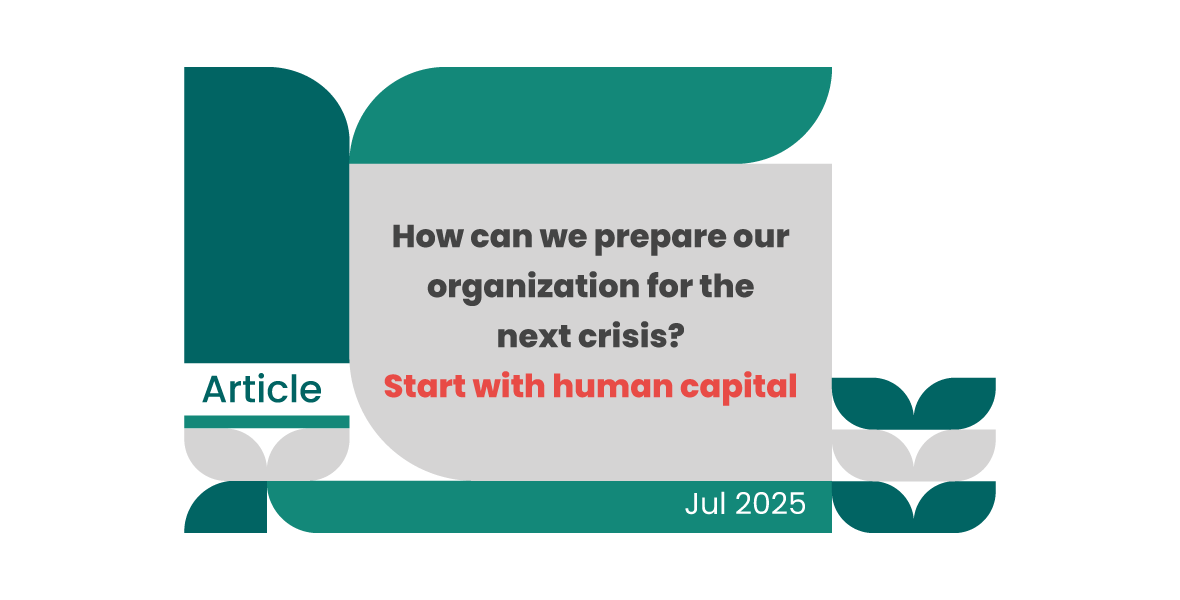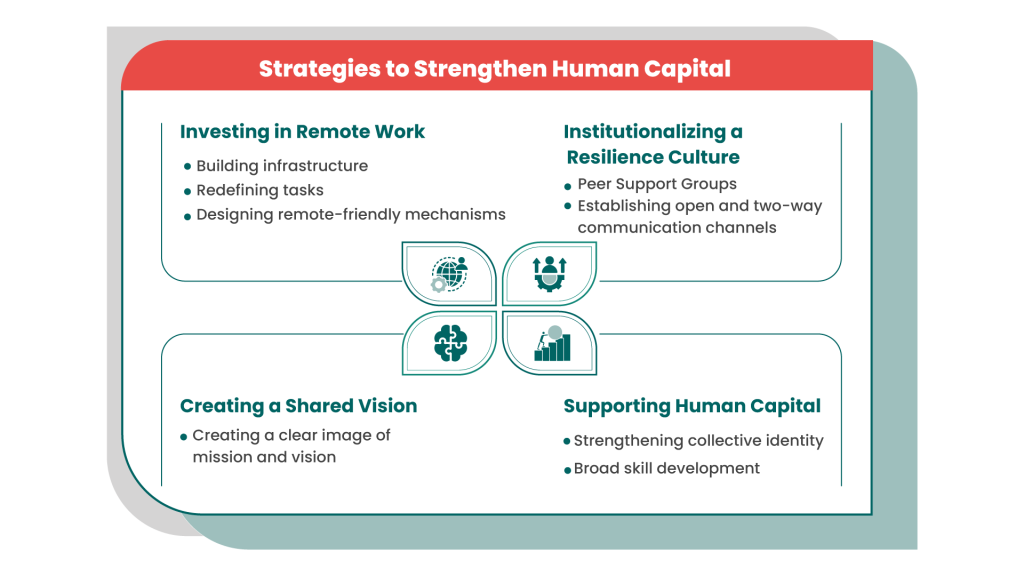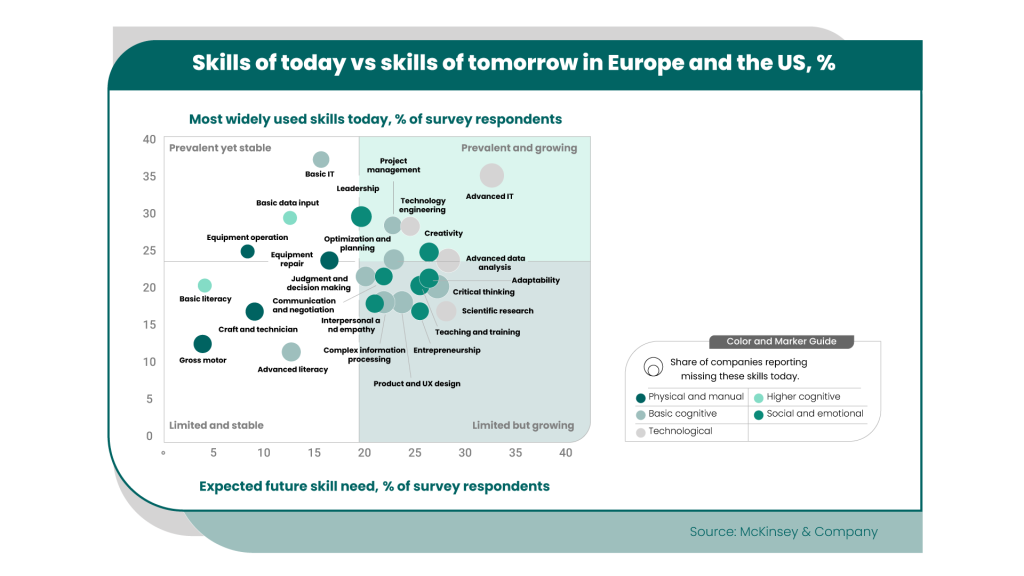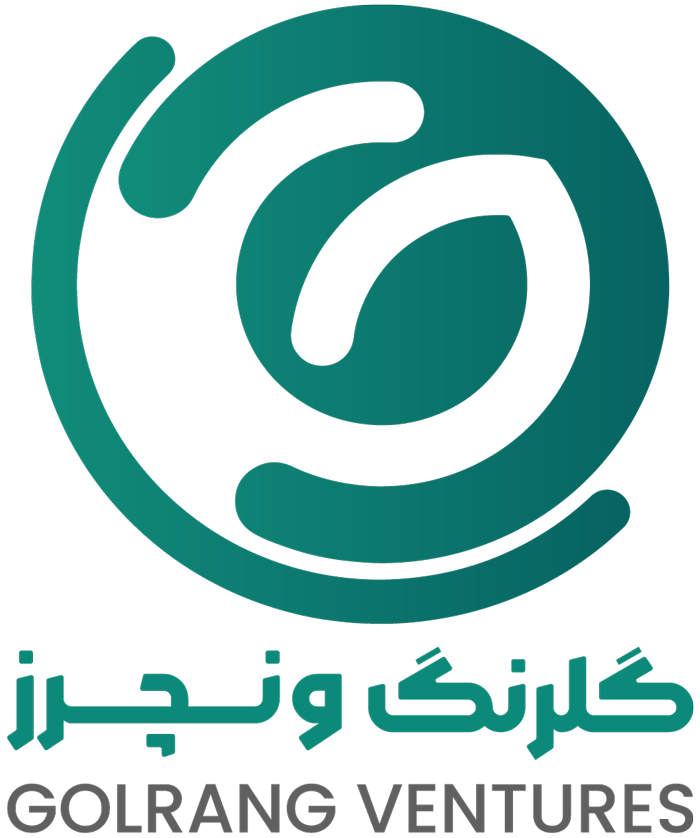
How can organizations prepare for the next crisis?
Start with human capital
Estimated reading time 10 min
Severe crises threaten organizational sustainability by impacting their most vulnerable yet valuable asset: human capital. In such situations, business resilience — the ability to adapt quickly and maintain continuity during emergencies — becomes essential. Experiences from conflict-affected environments such as Ukraine, Lebanon, and Syria, show that resilience goes beyond enduring short-term shocks. Rather, it involves the ongoing ability to adapt to instability and unpredictable change.[1],[2]
In the sections that follow, we explore key strategies that businesses — especially those operating in the challenging context of Iran — should consider to embed resilience into their organizational fabric.
Focusing on Human Capital Resilience

Investing in Remote Work Technology and Infrastructure
A company’s infrastructure is the first line of defense against the physical disruptions caused by crises. Modernizing digital infrastructure enables organizations to maintain critical services and operations despite external disturbances and constrains.
During the war in Ukraine, for instance, postal companies such as Nova Poshta and Ukrposhta demonstrated remarkable operational continuity, thanks to their advanced digital technologies. [3]
Similarly, the COVID-19 pandemic underscored the importance of remote work as a key factor in maintaining business operations during a crisis.
According to a Deloitte report, only 22% of organizations had the necessary infrastructure for remote collaboration — such as digital and cloud-based tools — in place prior to the pandemic, allowing them to adapt quickly and with minimal friction. In contrast, 42% of companies developed these technologies reactively, under pressure during 2020.[4]
Establishing cloud infrastructure, replacing desktop setups with laptops, and adopting organizational email systems are key measures that form the foundation of this preparedness.
However, in Iran, implementing such strategies presents unique challenges. Issues such as unstable internet connectivity, limited access to international tools, and increased cyberattacks require businesses to adopt a dual-track approach. This involves leveraging the best available global tools while simultaneously investing in reliable domestic alternatives — such as local video conferencing platforms (e.g., Skyroom) and project management tools (e.g., Mizito) — to ensure business continuity during crises.
Redefining Roles and Designing Remote-Friendly Workflows
In times of crisis, technology alone is not enough — “work” itself must be reimagined to suit the new context. Workforce planning platforms such as Degreed and Gloat offer tools that help organizations manage their human capital more strategically.
Team leaders and HR departments should focus on several key areas:
- Upskilling employees in response to changing circumstances
- Enabling internal mobility to prevent layoffs and retain institutional knowledge
- Aligning existing talent with the organization’s evolving needs
- Planning for succession amid uncertain
Finally, redefining jobs by shifting from task- or time-based models (e.g., person-hours) to outcome-based roles — and implementing hybrid work policies tailored to the nature of each role — can significantly enhance work quality and organizational resilience.
Institutionalizing a Culture of Resilience
A resilient organizational culture is built on the foundations of continuous learning, collaboration, diversity, and empowerment. This culture fosters trust, accountability, and innovation among employees and stakeholders — enabling the organization not only to anticipate and respond effectively to crises but also to grow through them. [5]
Research shows that social capital plays a vital role in organizational resilience. In organizations with networks of mutual trust and support, employees go beyond formal responsibilities and align closely with organizational goals, especially during times of crisis.
In practice, managers can strengthen social capital through the following actions:
Supporting Peer Support Groups
Often formed by a small number of volunteers, these groups provide a safe space for individuals affected by the crisis to share their experiences. They help reduce isolation and alleviate the psychological stress caused by difficult circumstances. [6]
Establishing Open and Two-Way Communication Channels
Actively listening to employees and their concerns — and fostering a two-way dialogue between management and staff — allows lived experiences during the crisis to be shared. This not only improves internal communication but also contributes to better job performance under challenging conditions. [7]
Creating a Shared Vision: The Organization’s Compass in Times of Uncertainty
Crises and their aftermath often disrupt the meaning of work and challenge an organization’s sense of purpose. In such pivotal moments, it becomes the responsibility of senior leaders to redefine this meaning by anchoring the company’s actions in its core values. This renewed sense of purpose may focus on rebuilding, serving the community, or promoting sustainability.
Examples include support campaigns launched by startups as part of their social responsibility efforts following the Shahid Rajaee port explosion or the Plasco building fire. Such initiatives infuse daily tasks with purpose and align employees along a shared path. [8]
A thought-provoking report titled “Marathon in the Fog,” published in 2025 by ILIYA Consulting, revealed that 72% of key personnel in Iranian organizations lacked a clear understanding of their company’s vision. This is concerning under normal circumstances — but during crises such as war or deep economic recession, it can be paralyzing.
The resilience of managers and key personnel becomes a vital asset in such times. Establishing a clear vision and mission — combined with regular cross-departmental meetings — helps identify and resolve challenges more swiftly. These efforts foster organizational trust and enhance employee resilience.
The Need to Support Human Capital: A Dual Strategy for Retention and Advancement
- In times of crisis, organizational human capital faces two major threats: the urge to exit — through migration or resignation — and a widening skills gap. A comprehensive strategy must address both dimensions.
a) Retaining Talent Through Strengthening Collective Identity
One key consequence of economic and social crises is increased workforce migration. In Ukraine, for example, the number of emigrants reached 3.5 million in 2022 — a 25% increase — while approximately 40% of businesses, around 200,000 companies, were forced to shut down. [9]
In Iran, data from the Iran Migration Yearbook, published by the Iranian Migration Observatory, shows that migration intent is particularly high among educated and skilled professionals.[10]
Another study found that only 15% of respondents said they were not considering emigration — highlighting the urgency for business leaders to invest in retaining their human capital.
In crisis contexts that undermine individual identity, a strong sense of collective identity and organizational belonging becomes psychologically vital. A study on the crisis in Lebanon found that companies that succeeded in cultivating a sense of “we-ness” and shared destiny were more effective at retaining staff and enhancing resilience.[11]
To foster this sense of cohesion, team managers can adopt a participatory approach to internal decision-making, building collective ownership and responsibility. Creating space for shared storytelling around the crisis can also help rebuild social cohesion within the organization.
b) Businesses Will Require Broad-Based Skills Upgrading
Crises often act as catalysts for technological and economic shifts. A 2024 McKinsey survey of executives revealed that around 40% of companies are experiencing significant talent shortages in advanced IT and programming, data analytics, and quantitative skills.
Moreover, European and American managers emphasized the growing need not only for technical expertise in IT and data analysis but also for critical thinking, creativity, problem structuring, and the ability to process complex information — skills essential for effective collaboration with emerging technologies (Figure 2).[12]

Reskilling as a Strategic Imperative
Companies increasingly view reskilling as essential to acquiring the capabilities needed to adapt to the evolving world of work. A McKinsey survey reveals that executives are concerned that failure to attract or develop these skills by 2030 could directly undermine their companies’ financial performance.
To bridge this skills gap, organizations typically rely on three approaches: reskilling, hiring, and outsourcing. Among these, reskilling has emerged as the primary strategy. However, the degree of need varies across industries — for example, it’s estimated that 36% of the automotive workforce will require reskilling, compared to 28% in the financial services sector.[13]
Conclusion
By investing in social capital, rebuilding collective identity, promoting a culture of adaptability, and providing psychosocial support, Iranian business leaders can not only prevent workforce attrition and brain drain but also build more cohesive, loyal, and resilient organizations — ones better equipped to face future challenges.
Resilience is not a final destination; it is a continuous process of building and rebuilding relationships and meaning. In this process, leadership plays a critical and transformative role.


